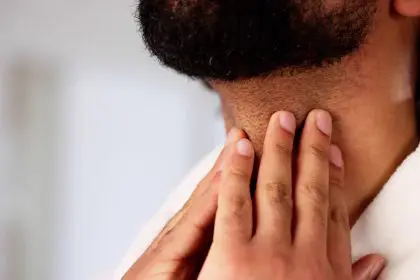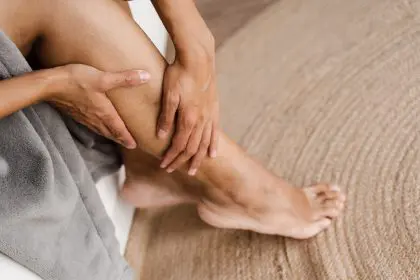We’ve all heard about deep breathing for anxiety. Take a deep breath in, exhale slowly, repeat until calm. It’s practically a wellness cliché at this point. But what if temporarily not breathing might actually work better to calm your racing mind? The idea sounds contradictory — even a bit scary — but emerging understanding about our nervous system suggests that strategic breath holding might be one of the most powerful and immediate anxiety interventions available.
This isn’t about holding your breath until you pass out. Rather, it’s about triggering specific physiological responses that can interrupt anxiety cycles within seconds. Let’s explore how this counterintuitive technique works and why it might be the missing piece in your stress management toolkit.
Why your body’s panic button gets stuck in the on position
Before diving into breath holding, it helps to understand what’s happening in your body during anxiety. Your autonomic nervous system — the involuntary control center responsible for functions like heart rate and digestion — has two primary branches that operate like a seesaw.
The sympathetic branch activates your fight-or-flight response, flooding your system with stress hormones, increasing heart rate, and preparing you for action. The parasympathetic branch triggers rest-and-digest mode, slowing your heart, increasing digestion, and creating feelings of calm and safety.
Anxiety essentially keeps your sympathetic nervous system stuck in the on position. Your body behaves as if a threat is present even when you’re perfectly safe. This physiological state makes logical thinking nearly impossible — you can’t reason your way out of anxiety because the thinking part of your brain takes a backseat during perceived emergencies.
What makes anxiety particularly challenging is how it feeds itself. The physical sensations of anxiety — racing heart, shallow breathing, lightheadedness — often become triggers for more anxiety. Your brain misinterprets these sensations as confirmation that something is truly wrong, creating a self-perpetuating cycle.
The carbon dioxide connection you never knew about
One of the most overlooked aspects of anxiety physiology involves carbon dioxide levels in your blood. Many anxiety sufferers unknowingly hyperventilate, breathing too quickly and exhaling too much carbon dioxide. While we typically think of carbon dioxide as merely a waste gas, it actually plays a crucial regulatory role in your body.
When carbon dioxide levels fall too low due to over-breathing, it triggers a cascade of effects including blood vessel constriction, reduced blood flow to the brain, and an increase in nerve cell excitability. These physical changes can manifest as dizziness, tingling sensations, and heightened alarm — all sensations that further fuel anxiety.
Even more surprising, appropriate carbon dioxide levels actually have a calming effect on your nervous system. Carbon dioxide acts as a natural tranquilizer by moderating nervous system excitability. When levels are optimal, your brain and body remain in a balanced state where anxiety has a harder time taking hold.
This explains why traditional advice to “take deep breaths” sometimes backfires for anxiety sufferers. If those deep breaths turn into over-breathing, they can actually worsen the physiological anxiety state rather than improve it.
How brief breath holding resets your system
Enter breath holding as an intervention. Brief, controlled breath holds achieve something remarkable — they rapidly increase carbon dioxide levels in your bloodstream, essentially functioning as a physiological reset button for your nervous system.
When you hold your breath, carbon dioxide builds up in your system. This rise triggers several beneficial responses:
It activates the parasympathetic nervous system, initiating the calming rest-and-digest state.
It dilates blood vessels, improving blood flow to the brain and reducing lightheadedness.
It reduces the excitability of your nervous system, making it harder for anxious thoughts to cascade out of control.
It interrupts hyperventilation patterns that perpetuate anxiety states.
Perhaps most importantly, these physiological changes happen rapidly — often within seconds — making breath holding one of the fastest-acting anxiety interventions available.
The specific technique that works better than random holding
Not all breath holding is created equal when it comes to anxiety relief. The technique matters significantly. The most effective approach combines specific timing, posture, and awareness elements to maximize the anti-anxiety benefits.
The basic technique involves a normal inhale followed by a comfortable breath hold, but with key refinements:
Take a normal breath in through your nose — not deep, just normal.
Hold this breath comfortably for a count that feels manageable — start with 5-10 seconds if you’re new to this.
When you resume breathing, do so gently through your nose, keeping your next few breaths lighter and slower than normal.
Repeat this process 3-4 times with normal breathing in between holds.
What makes this approach different from random breath holding is the emphasis on normal inhalation rather than maximal inhalation. A full deep breath before holding actually makes the technique less effective by flooding your system with too much oxygen, potentially prolonging the anxiety state.
The focus on nasal breathing is equally important. Breathing through your nose activates nasal nitric oxide production, which helps regulate blood pressure and nervous system function. Mouth breathing bypasses these benefits and often leads to over-breathing.
When and where to use this invisible anxiety intervention
One advantage of breath holding for anxiety is its discretion. Unlike many coping techniques that require obvious actions or removing yourself from situations, breath holding can be done anywhere without drawing attention.
This makes it particularly valuable during social anxiety moments, work presentations, difficult conversations, or other scenarios where you need immediate relief without others noticing. You can literally reset your nervous system mid-conversation without the other person realizing what you’re doing.
For anticipatory anxiety — the worry that builds before stressful events — practicing this technique 5-10 minutes before facing the stressful situation can create a buffer of physiological calm that makes you more resilient when stress actually arrives.
During midnight anxiety spirals when racing thoughts keep you awake, breath holding can short-circuit the cycle, allowing your nervous system to downshift into a state more conducive to sleep. The technique works particularly well when combined with lying on your right side, a position that naturally activates parasympathetic function.
Why swimmers and freedivers rarely have panic attacks
Intriguingly, people who regularly practice sports involving breath control, like swimming, diving, and especially freediving, report unusually low rates of anxiety and panic disorders. This real-world evidence supports the neurological connection between breath holding and anxiety regulation.
Freedivers, who train to hold their breath for extended periods, develop exceptional carbon dioxide tolerance. This training essentially recalibrates their nervous system’s response to carbon dioxide fluctuations, making them less susceptible to the physiological triggers that can spark anxiety.
While you don’t need to become a freediver to benefit from breath holding, this connection highlights how regular practice can create lasting changes in your anxiety response patterns. The more you use controlled breath holding during mild anxiety, the more effectively your body learns to regulate its stress response overall.
The broader breathing approach that maintains the benefits
While breath holding works remarkably well for interrupting acute anxiety, a broader approach to breathing helps maintain the benefits over time. The goal is training your breathing pattern to maintain optimal carbon dioxide levels throughout the day.
Nasal breathing becomes particularly important in this maintenance phase. Breathing primarily through your nose naturally limits air volume, helping maintain appropriate carbon dioxide levels. It also filters, warms, and humidifies incoming air, reducing respiratory system irritation that can contribute to anxiety.
Slower breathing rates support this balance as well. Aiming for a relaxed rate of 10-12 breaths per minute during normal activities helps prevent the chronic hyperventilation that often underlies anxiety disorders. Over time, this rate can be gently reduced further to 6-8 breaths per minute during relaxed states.
Diaphragmatic breathing, where your belly expands on inhale rather than your chest and shoulders rising, activates parasympathetic response and improves breathing efficiency. Practicing this style of breathing when you’re not anxious makes it easier to access during stressful moments.
The scientific backing that validates this approach
The breath-holding approach to anxiety isn’t just anecdotal — it’s grounded in our understanding of respiratory physiology and nervous system function. The role of carbon dioxide in anxiety has been studied since the 1980s, with research confirming that reduced carbon dioxide sensitivity correlates with reduced anxiety symptoms.
More recent research in polyvagal theory highlights how breathing patterns directly influence vagal nerve tone — a key mediator of parasympathetic function and anxiety regulation. Brief breath holds have been shown to stimulate vagal activity, supporting the physiological mechanism behind this technique’s effectiveness.
Clinical applications of these principles appear in various therapeutic approaches, including the Buteyko method and certain forms of cognitive behavioral therapy for panic disorder. These approaches specifically target hyperventilation and carbon dioxide levels as central factors in anxiety management.
While breath holding isn’t a complete solution for clinical anxiety disorders, it represents a powerful physiological intervention that works with your body’s natural mechanisms rather than against them. When used as part of a comprehensive approach to anxiety management, it provides a rapid-response tool that can prevent escalation and create windows of calm where deeper work can occur.
The next time anxiety starts to rise, consider trying this counterintuitive approach. Your next breath — or brief pause in breathing — might be the most effective anxiety intervention you’ve never tried.














